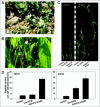Physiological regulation and functional significance of shade avoidance responses to neighbors
- PMID: 20404496
- PMCID: PMC3001554
- DOI: 10.4161/psb.5.6.11401
Physiological regulation and functional significance of shade avoidance responses to neighbors
Abstract
Plants growing in dense vegetations compete with their neighbors for resources such as water, nutrients and light. The competition for light has been particularly well studied, both for its fitness consequences as well as the adaptive behaviors that plants display to win the battle for light interception. Aboveground, plants detect their competitors through photosensory cues, notably the red:far-red light ratio (R:FR). The R:FR is a very reliable indicator of future competition as it decreases in a plant-specific manner though red light absorption for photosynthesis and is sensed with the phytochrome photoreceptors. In addition, also blue light depletion is perceived for neighbor detection. As a response to these light signals plants display a suite of phenotypic traits defined as the shade avoidance syndrome (SAS). The SAS helps to position the photosynthesizing leaves in the higher zones of a canopy where light conditions are more favorable. In this review we will discuss the physiological control mechanisms through which the photosensory signals are transduced into the adaptive phenotypic responses that make up the SAS. Using this mechanistic knowledge as a starting point, we will discuss how the SAS functions in the context of the complex multi-facetted environments that plants usually grow in.
Figures



References
-
- Novoplansky A. Picking battles wisely: plant behaviour under competition. Plant Cell Environ. 2009;32:726–741. - PubMed
-
- Vandenbussche F, Pierik R, Millenaar FF, Voesenek LACJ, Van der Straeten D. Reaching out of the shade. Curr Opin Plant Biol. 2005;8:462–468. - PubMed
-
- Franklin KA. Shade avoidance. New Phytol. 2008;179:930–944. - PubMed
-
- Pierik R, Whitelam GC, Voesenek LACJ, de Kroon H, Visser EJW. Canopy studies on ethylene-insensitive tobacco identify ethylene as a novel element in blue light and plant-plant signalling. Plant J. 2004;38:310–319. - PubMed
-
- Kegge W, Pierik R. BVOCs and plant competition. Trends Plant Sci. 2010;15:126–132. - PubMed
Publication types
MeSH terms
LinkOut - more resources
Full Text Sources
Other Literature Sources
Research Materials
Miscellaneous
